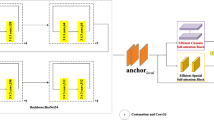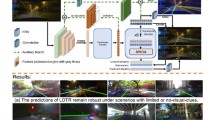Abstract
One of the primary responsibilities of an autonomous driving system is lane detecting. We propose modeling lane markings using Catmull-Rom curves, as opposed to segmentation-based approaches and point detection-based methods, which input images captured by monocular cameras and output lane markings represented by Catmull-Rom segments. The Catmull-Rom segment fits the lane lines more closely than the cubic polynomial and is stable and simple to construct (tested on the TuSimple dataset). We also suggest a spatial attention module to take advantage of lane lines’ nearly vertical distribution. Our suggested approach strikes a balance between accuracy and real-time. In the Tusimple dataset, our model’s accuracy is 0.45% more accurate than the cubic polynomial model (PolyLaneNet). These results demonstrated the suitability of our approach for the lane detecting task.





Similar content being viewed by others
Explore related subjects
Discover the latest articles and news from researchers in related subjects, suggested using machine learning.Availability of data and materials
This article uses two publicly available datasets: TuSimple dataset and CULane dataset.
References
Cheng, Y.-T., Patel, A., Wen, C., Bullock, D., Habib, A.: Intensity thresholding and deep learning based lane marking extraction and lane width estimation from mobile light detection and ranging (lidar) point clouds. Remote Sens. 12(9), 1379 (2020)
Rastiveis, H., Shams, A., Sarasua, W.A., Li, J.: Automated extraction of lane markings from mobile lidar point clouds based on fuzzy inference. ISPRS J. Photogram. Remote Sens. 160, 149–166 (2020)
Hou, Y., Ma, Z., Liu, C., Loy, C.C.: Learning lightweight lane detection cnns by self attention distillation. In: Proceedings of the IEEE/CVF International Conference on Computer Vision, pp. 1013–1021 (2019)
Pan, X., Shi, J., Luo, P., Wang, X., Tang, X.: Spatial as deep: Spatial cnn for traffic scene understanding. In: Proceedings of the AAAI Conference on Artificial Intelligence, Vol. 32 (2018)
Tabelini, L., Berriel, R., Paixao, T.M., Badue, C., De Souza, A.F., Oliveira-Santos, T.: Keep your eyes on the lane: Real-time attention-guided lane detection. In: Proceedings of the IEEE/CVF Conference on Computer Vision and Pattern Recognition, pp. 294–302 (2021)
Zheng, T., Fang, H., Zhang, Y., Tang, W., Yang, Z., Liu, H., Cai, D.: Resa: Recurrent feature-shift aggregator for lane detection. In: Proceedings of the AAAI Conference on Artificial Intelligence, 35, 3547–3554 (2021)
Berriel, R.F., de Aguiar, E., De Souza, A.F., Oliveira-Santos, T.: Ego-lane analysis system (elas): Dataset and algorithms. Image Vis. Comput. 68, 64–75 (2017)
Deng, G., Wu, Y.: Double lane line edge detection method based on constraint conditions hough transform. In: 2018 17th International Symposium on Distributed Computing and Applications for Business Engineering and Science (DCABES), pp. 107–110 (2018). IEEE
Lee, S., Kim, J., Shin Yoon, J., Shin, S., Bailo, O., Kim, N., Lee, T.-H., Seok Hong, H., Han, S.-H., So Kweon, I.: Vpgnet: Vanishing point guided network for lane and road marking detection and recognition. In: Proceedings of the IEEE International Conference on Computer Vision, pp. 1947–1955 (2017)
Li, X., Li, J., Hu, X., Yang, J.: Line-cnn: End-to-end traffic line detection with line proposal unit. IEEE Trans. Intell. Transp. Syst. 21(1), 248–258 (2019)
Qu, Z., Jin, H., Zhou, Y., Yang, Z., Zhang, W.: Focus on local: Detecting lane marker from bottom up via key point. In: Proceedings of the IEEE/CVF Conference on Computer Vision and Pattern Recognition, pp. 14122–14130 (2021)
Liu, R., Yuan, Z., Liu, T., Xiong, Z.: End-to-end lane shape prediction with transformers. In: Proceedings of the IEEE/CVF Winter Conference on Applications of Computer Vision, pp. 3694–3702 (2021)
Tabelini, L., Berriel, R., Paixao, T.M., Badue, C., De Souza, A.F., Oliveira-Santos, T.: Polylanenet: Lane estimation via deep polynomial regression. In: 2020 25th International Conference on Pattern Recognition (ICPR), pp. 6150–6156. IEEE (2021)
Liu, Z., Mao, H., Wu, C.-Y., Feichtenhofer, C., Darrell, T., Xie, S.: A convnet for the 2020s. In: Proceedings of the IEEE/CVF Conference on Computer Vision and Pattern Recognition, pp. 11976–11986 (2022)
Yin, X., Zhang, J., Wu, X., Huang, J., Xu, Y., Zhu, L.: An improved lane departure warning algorithm based on fusion of f-Kalman filter and f-TLC. Multimed. Tools Appl. 78(9), 12203–12222 (2019)
Ghafoorian, M., Nugteren, C., Baka, N., Booij, O., Hofmann, M.: El-gan: Embedding loss driven generative adversarial networks for lane detection. In: Proceedings of the European Conference on Computer Vision (ECCV) Workshops (2018)
Neven, D., De Brabandere, B., Georgoulis, S., Proesmans, M., Van Gool, L.: Towards end-to-end lane detection: an instance segmentation approach. In: 2018 IEEE Intelligent Vehicles Symposium (IV), pp. 286–291. IEEE (2018)
Yoo, S., Lee, H.S., Myeong, H., Yun, S., Park, H., Cho, J., Kim, D.H.: End-to-end lane marker detection via row-wise classification. In: Proceedings of the IEEE/CVF Conference on Computer Vision and Pattern Recognition Workshops, pp. 1006–1007 (2020)
Feng, Z., Guo, S., Tan, X., Xu, K., Wang, M., Ma, L.: Rethinking efficient lane detection via curve modeling. In: Proceedings of the IEEE/CVF Conference on Computer Vision and Pattern Recognition, pp. 17062–17070 (2022)
Wang, Y., Shen, D., Teoh, E.K.: Lane detection using spline model. Pattern Recognit. Lett. 21(8), 677–689 (2000)
Mechat, N., Saadia, N., M’Sirdi, N., Djelal, N.: Lane detection and tracking by monocular vision system in road vehicle. In: 2012 5th International Congress on Image and Signal Processing, 1276–1282. IEEE (2012)
Hou, Q., Zhou, D., Feng, J.: Coordinate attention for efficient mobile network design. In: Proceedings of the IEEE/CVF Conference on Computer Vision and Pattern Recognition, pp. 13713–13722 (2021)
Hu, J., Shen, L., Sun, G.: Squeeze-and-excitation networks. In: Proceedings of the IEEE Conference on Computer Vision and Pattern Recognition, pp. 7132–7141 (2018)
Funding
(1) National Key Research and Development Program of China(2017YFB0102500). (2) National Natural Science Foundation of China (62172186)
Author information
Authors and Affiliations
Contributions
(1) Jindong Zhang is responsible for writing the paper and providing the experimental platform. (2) Haoting Zhong was responsible for refining the method and designing the experiments.
Corresponding author
Ethics declarations
Competing interests
I declare that the authors have no competing interests as defined by Springer, or other interests that might be perceived to influence the results and/or discussion reported in this paper.
Ethics Approval
Not applicable
Additional information
Publisher's Note
Springer Nature remains neutral with regard to jurisdictional claims in published maps and institutional affiliations.
Rights and permissions
Springer Nature or its licensor (e.g. a society or other partner) holds exclusive rights to this article under a publishing agreement with the author(s) or other rightsholder(s); author self-archiving of the accepted manuscript version of this article is solely governed by the terms of such publishing agreement and applicable law.
About this article
Cite this article
Zhang, J., Zhong, H. Curve-based lane estimation model with lightweight attention mechanism. SIViP 17, 2637–2643 (2023). https://doi.org/10.1007/s11760-022-02480-0
Received:
Revised:
Accepted:
Published:
Issue Date:
DOI: https://doi.org/10.1007/s11760-022-02480-0




